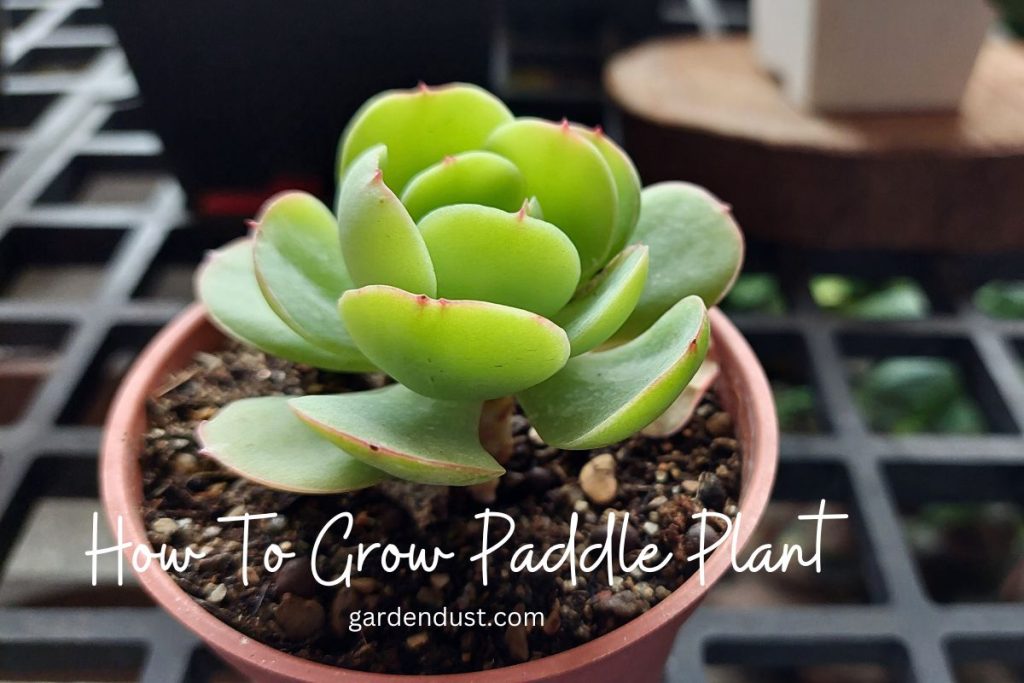The Paddle Plant (Kalanchoe Luciae), with its distinctive paddle-shaped leaves and striking appearance, is a popular succulent known for its unique charm and ease of cultivation. Native to South Africa, this hardy plant has become a favorite among succulent enthusiasts and gardeners alike. In this comprehensive guide, we will explore How To Grow Paddle Plant(Kalanchoe Luciae), providing valuable insights for both beginners and experienced cultivators. Let’s start…
Botanical Name-Kalanchoe luciae
Native-South Africa
Family-Crassulaceae
Genus-Kalanchoe
Common Name-Paddle Plant or Flapjack Plant
Plant Type-Succulent
Plant Size-height 1 -2 feet
Growing Care For Paddle Plant
Selecting an appropriate location is crucial for the successful growth of the Paddle Plant. This succulent thrives in bright, indirect sunlight, making it well-suited for locations with filtered sunlight or partial shade. While it can tolerate some direct sunlight, it’s essential to avoid prolonged exposure, especially in regions with intense afternoon sun, to prevent leaf scorching.
Whether grown indoors or outdoors, ensure the Paddle Plant receives ample light for at least six hours a day. When cultivating indoors, place the plant near a south-facing window to provide the necessary light conditions. Outdoors, consider planting in well-draining soil in a location with dappled sunlight to promote optimal growth.
Soil Requirements & Potting Mix
The Paddle Plant thrives in well-draining soil to prevent waterlogged conditions, which can lead to root rot. Use a specialized cactus or succulent mix or create a custom blend with equal parts potting soil, perlite, and coarse sand. When planting in containers, ensure the pots have drainage holes to allow excess water to escape.
Repot the Paddle Plant every 2-3 years, or when it outgrows its current container. During repotting, inspect the roots for signs of rot or overcrowding, trimming as necessary. This helps maintain the plant’s health and ensures proper aeration of the roots.
Watering and Humidity
Proper watering is crucial for the Paddle Plant, as it is susceptible to overwatering. Allow the soil to dry out completely between waterings, and water sparingly during the dormant period in winter. When watering, provide a thorough soak, allowing excess water to drain away.
The Paddle Plant is adapted to low humidity conditions, making it well-suited for arid environments. Avoid overwatering or misting the plant excessively to prevent fungal issues. Adequate airflow is beneficial, especially in indoor environments, to maintain an optimal environment for the succulent.
READ ALSO:-HOW TO GROW CARE FOR SEA HOLLY
Temperature and Environmental Conditions
The Paddle Plant thrives in warm temperatures and is well-suited for USDA hardiness zones 9-11. It can tolerate temperatures as low as 20°F (-6°C), but protection from frost is essential. When grown indoors, maintain temperatures between 60-75°F (15-24°C) for optimal growth.
Good air circulation is important to prevent the onset of fungal diseases. Ensure proper spacing if planting multiple Paddle Plants, whether in containers or in garden beds, to allow for adequate airflow and minimize the risk of moisture-related issues.
Fertilizer
Fertilize the Paddle Plant sparingly during the growing season (spring and summer) with a balanced, water-soluble fertilizer formulated for succulents. Dilute the fertilizer to half the recommended strength to prevent overfeeding. Refrain from fertilizing during the dormant period in winter when the plant’s growth naturally slows.
Monitor the plant’s response to feeding, adjusting the frequency based on its appearance and overall health. Too much fertilizer can lead to excessive growth, impacting the succulent’s natural form.
Pruning care
Pruning the Paddle Plant is generally minimal, as it maintains a tidy and compact shape naturally. However, remove any dead or damaged leaves with clean, sharp scissors or pruning shears to encourage new growth. Trim leggy stems to maintain the plant’s aesthetic appeal.
Regularly check for pests such as aphids, mealybugs, or scale. If infestations occur, treat affected areas with insecticidal soap or neem oil. Wipe the leaves with a damp cloth to remove dust, allowing for better light absorption.
Common Pests and Diseases
While the Paddle Plant is relatively resistant to pests, occasional challenges may arise. Keep a watchful eye for aphids, mealybugs, or scale insects, especially when grown indoors. Treat any infestations promptly with natural remedies or insecticidal solutions to prevent further damage.
To avoid fungal diseases, maintain proper watering practices and provide adequate air circulation. Avoid overhead watering, as water sitting on the leaves can lead to issues such as leaf rot. In outdoor settings, ensure proper spacing to minimize the risk of fungal infections.
Propagation
The Paddle Plant can be propagated easily through offsets or leaf cuttings. When removing offsets, allow them to dry and callus for a day before planting in well-draining soil. Water sparingly until roots develop. Leaf cuttings can be taken from healthy leaves, left to air dry for a day, and then planted in a succulent or cactus mix. Keep the soil consistently moist until roots establish.
Cultivating the Paddle Plant is a rewarding experience, offering a unique addition to gardens and indoor collections. By providing the right light, well-draining soil, and attentive care, enthusiasts can enjoy the beauty and resilience of this captivating succulent. Whether grown as a standalone specimen or part of a succulent garden, the Paddle Plant‘s distinctive form and minimal maintenance make it an ideal choice for both beginners and seasoned succulent enthusiasts. Happy Gardening….






